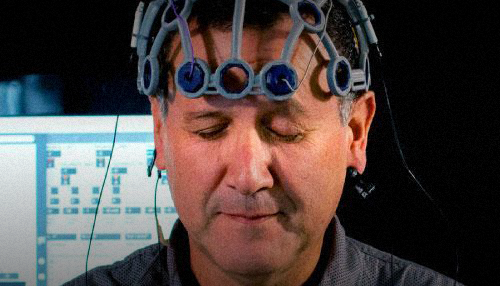
Interpolation
El prototipo propone un modelo de neurofeedback a través de cuatro altavoces especializados para reproducir paneles tridimensionales según la navegación de la GUI.
El usuario se sitúa en el centro de los altavoces frente a una pantalla: puede ser capaz de mover y transformar el cursor a voluntad, así como detener el movimiento a través de un estado de relajación, permitiendo que el sistema vuelva a un estado neutral.
El equipo experimental utilizado en este experimento fue un OpenBCI para la adquisición de la señal de EEG, una pantalla para la visualización de la GUI, dos cámaras una para la grabación facial de los participantes y la segunda para la grabación general del experimento. Asimismo, fue necesario utilizar dos ordenadores, uno para la adquisición de la señal y el proceso de reconocimiento de patrones, y el segundo para el procesamiento Max/MSP, y un sistema de audio cuadrafónico para la inmersión sonora.
el control del estado del cerebro ha sido bien establecido en el área de las interfaces cerebro-ordenador durante las últimas décadas en las que las aplicaciones activas permiten controlar dispositivos externos de forma consciente. El propósito de este estudio fue desarrollar un sistema de representación gráfica del sonido en tiempo real basado en un diseño de interacción que permite navegar por la tarea cognitiva de imágenes motoras en un plano bidimensional.
Esta representación se desarrolló utilizando el sistema de adquisición de EEG OpenBCI para registrar la información necesaria que fue enviada y procesada en el software Max/MSP. El sistema opera bajo una Interfaz Gráfica de Usuario (GUI) metafórica programada en Processing.
El sistema se probó mediante un experimento en condiciones controladas en el que participaron seis músicos profesionales. A partir de los resultados experimentales, se encontró que todos los participantes alcanzaron diferentes niveles de control asociados a su respuesta estática y dinámica con un promedio de 26,73% y 73,27% respectivamente.
- https://www.researchgate.net/publication/334371293_Interpolation_a_Model_for_Sound_Representation_Based_on_BCI
- https://books.google.com/books/about/Augmented_Cognition.html?id=xqKhDwAAQBAJ
- https://www.youtube.com/watch?v=UDHCT4mclI0&ab_channel=EntornoSonoroyVisual
- https://www.youtube.com/watch?v=qoX7X48nIPk&ab_channel=EntornoSonoroyVisual
- https://www.youtube.com/watch?v=lltjRF4-nac&ab_channel=EntornoSonoroyVisual
- https://link.springer.com/chapter/10.1007/978-3-030-22419-6_34